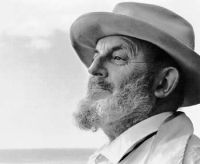A Brief History of Photography
Film
 Photography as it is known today was created in the mid-19th century. George Eastman invented film in 1884. An image is produced by applying chemicals to a photo-sensitive strip coated with a silver compound. The parts of the film that were subjected to higher amounts of light turned darker. The result of this is what is now known as the negative. It used to take several minutes for the camera to gather enough light to create a discernable image on the film, which is why old photographs were all static - there was no inferred motion.
Photography as it is known today was created in the mid-19th century. George Eastman invented film in 1884. An image is produced by applying chemicals to a photo-sensitive strip coated with a silver compound. The parts of the film that were subjected to higher amounts of light turned darker. The result of this is what is now known as the negative. It used to take several minutes for the camera to gather enough light to create a discernable image on the film, which is why old photographs were all static - there was no inferred motion.
Color
 The first color photograph was successfully taken in 1861. Early on, color was achieved by using three cameras that would each collect the light from a specific color, and then combining these negatives in a dark room. Color film became commercially available in 1907. In 1935, Kodak created agruably the most successful and well-known color film: Kodachrome. It had three layers, each one was chemically sensitive to only one color - red, green, or blue. Another color film - polaroid - was developed in 1963.
The first color photograph was successfully taken in 1861. Early on, color was achieved by using three cameras that would each collect the light from a specific color, and then combining these negatives in a dark room. Color film became commercially available in 1907. In 1935, Kodak created agruably the most successful and well-known color film: Kodachrome. It had three layers, each one was chemically sensitive to only one color - red, green, or blue. Another color film - polaroid - was developed in 1963.
Digital
 Digital cameras work by collecting particles of light [called photons] on an electronic sensor instead of on a film. There are two popular types of digital sensors: the charge-coupled device, or CCD, and the complementary metal oxide semiconductor, or CMOS. The difference between the two sensors is small enough where the inclusion of one over the other needn't be a factor when deciding on a camera to buy. The first commercially available fully-digital camera came out in 1991. Produced by Kodak, the DCS 100 was incredibly expensive, so only commercial and professional photographers were able to buy them. By the early 21st century, production had increased enough and prices had dropped enough to make digital cameras a common household item.
Digital cameras work by collecting particles of light [called photons] on an electronic sensor instead of on a film. There are two popular types of digital sensors: the charge-coupled device, or CCD, and the complementary metal oxide semiconductor, or CMOS. The difference between the two sensors is small enough where the inclusion of one over the other needn't be a factor when deciding on a camera to buy. The first commercially available fully-digital camera came out in 1991. Produced by Kodak, the DCS 100 was incredibly expensive, so only commercial and professional photographers were able to buy them. By the early 21st century, production had increased enough and prices had dropped enough to make digital cameras a common household item.
Ansel Adams
 Ansel Adams has one of the most recognized names in photography. As a photographer and an environmentalist, he is most well-known for his iconic black-and-white images of Yosemtite National Park. He penned several books on photography, and is considered to be one of the best nature photographers of all time. His photograph The Tetons and the Snake River was one of 115 photographs that were sent into space to convey information about Earth to alien civilizations on the Voyager spacecraft.
Ansel Adams has one of the most recognized names in photography. As a photographer and an environmentalist, he is most well-known for his iconic black-and-white images of Yosemtite National Park. He penned several books on photography, and is considered to be one of the best nature photographers of all time. His photograph The Tetons and the Snake River was one of 115 photographs that were sent into space to convey information about Earth to alien civilizations on the Voyager spacecraft.
Jim Brandenburg
 Jim Brandenburg is a local Minnesota photographer. Born in Luverne, he now resides in the Ely area after working as a photographer for National Geographic for 25 years. He is most well-known for the documentary he made about white wolves on Ellesmere Island in extreme northern Canada, and the two books he has published where he limited himself to taking only a single photograph each day over the course of 90 days. In 1999, he established the Brandenburg Prairie Foundation in an effort to help restore tallgrass prairie in southwest Minnesota. To date, the foundation has purchased over 800 acres in Rock County, which is called the "Touch the Sky Northern Tallgrass Prairie National Wildlife Refuge," with the hopes that bison will one day roam the prairies of southern Minnesota again.
Jim Brandenburg is a local Minnesota photographer. Born in Luverne, he now resides in the Ely area after working as a photographer for National Geographic for 25 years. He is most well-known for the documentary he made about white wolves on Ellesmere Island in extreme northern Canada, and the two books he has published where he limited himself to taking only a single photograph each day over the course of 90 days. In 1999, he established the Brandenburg Prairie Foundation in an effort to help restore tallgrass prairie in southwest Minnesota. To date, the foundation has purchased over 800 acres in Rock County, which is called the "Touch the Sky Northern Tallgrass Prairie National Wildlife Refuge," with the hopes that bison will one day roam the prairies of southern Minnesota again.
 Photography as it is known today was created in the mid-19th century. George Eastman invented film in 1884. An image is produced by applying chemicals to a photo-sensitive strip coated with a silver compound. The parts of the film that were subjected to higher amounts of light turned darker. The result of this is what is now known as the negative. It used to take several minutes for the camera to gather enough light to create a discernable image on the film, which is why old photographs were all static - there was no inferred motion.
Photography as it is known today was created in the mid-19th century. George Eastman invented film in 1884. An image is produced by applying chemicals to a photo-sensitive strip coated with a silver compound. The parts of the film that were subjected to higher amounts of light turned darker. The result of this is what is now known as the negative. It used to take several minutes for the camera to gather enough light to create a discernable image on the film, which is why old photographs were all static - there was no inferred motion.
 The first color photograph was successfully taken in 1861. Early on, color was achieved by using three cameras that would each collect the light from a specific color, and then combining these negatives in a dark room. Color film became commercially available in 1907. In 1935, Kodak created agruably the most successful and well-known color film: Kodachrome. It had three layers, each one was chemically sensitive to only one color - red, green, or blue. Another color film - polaroid - was developed in 1963.
The first color photograph was successfully taken in 1861. Early on, color was achieved by using three cameras that would each collect the light from a specific color, and then combining these negatives in a dark room. Color film became commercially available in 1907. In 1935, Kodak created agruably the most successful and well-known color film: Kodachrome. It had three layers, each one was chemically sensitive to only one color - red, green, or blue. Another color film - polaroid - was developed in 1963.
 Digital cameras work by collecting particles of light [called photons] on an electronic sensor instead of on a film. There are two popular types of digital sensors: the charge-coupled device, or CCD, and the complementary metal oxide semiconductor, or CMOS. The difference between the two sensors is small enough where the inclusion of one over the other needn't be a factor when deciding on a camera to buy. The first commercially available fully-digital camera came out in 1991. Produced by Kodak, the DCS 100 was incredibly expensive, so only commercial and professional photographers were able to buy them. By the early 21st century, production had increased enough and prices had dropped enough to make digital cameras a common household item.
Digital cameras work by collecting particles of light [called photons] on an electronic sensor instead of on a film. There are two popular types of digital sensors: the charge-coupled device, or CCD, and the complementary metal oxide semiconductor, or CMOS. The difference between the two sensors is small enough where the inclusion of one over the other needn't be a factor when deciding on a camera to buy. The first commercially available fully-digital camera came out in 1991. Produced by Kodak, the DCS 100 was incredibly expensive, so only commercial and professional photographers were able to buy them. By the early 21st century, production had increased enough and prices had dropped enough to make digital cameras a common household item.
 Ansel Adams has one of the most recognized names in photography. As a photographer and an environmentalist, he is most well-known for his iconic black-and-white images of Yosemtite National Park. He penned several books on photography, and is considered to be one of the best nature photographers of all time. His photograph The Tetons and the Snake River was one of 115 photographs that were sent into space to convey information about Earth to alien civilizations on the Voyager spacecraft.
Ansel Adams has one of the most recognized names in photography. As a photographer and an environmentalist, he is most well-known for his iconic black-and-white images of Yosemtite National Park. He penned several books on photography, and is considered to be one of the best nature photographers of all time. His photograph The Tetons and the Snake River was one of 115 photographs that were sent into space to convey information about Earth to alien civilizations on the Voyager spacecraft.
 Jim Brandenburg is a local Minnesota photographer. Born in Luverne, he now resides in the Ely area after working as a photographer for National Geographic for 25 years. He is most well-known for the documentary he made about white wolves on Ellesmere Island in extreme northern Canada, and the two books he has published where he limited himself to taking only a single photograph each day over the course of 90 days. In 1999, he established the Brandenburg Prairie Foundation in an effort to help restore tallgrass prairie in southwest Minnesota. To date, the foundation has purchased over 800 acres in Rock County, which is called the "Touch the Sky Northern Tallgrass Prairie National Wildlife Refuge," with the hopes that bison will one day roam the prairies of southern Minnesota again.
Jim Brandenburg is a local Minnesota photographer. Born in Luverne, he now resides in the Ely area after working as a photographer for National Geographic for 25 years. He is most well-known for the documentary he made about white wolves on Ellesmere Island in extreme northern Canada, and the two books he has published where he limited himself to taking only a single photograph each day over the course of 90 days. In 1999, he established the Brandenburg Prairie Foundation in an effort to help restore tallgrass prairie in southwest Minnesota. To date, the foundation has purchased over 800 acres in Rock County, which is called the "Touch the Sky Northern Tallgrass Prairie National Wildlife Refuge," with the hopes that bison will one day roam the prairies of southern Minnesota again.